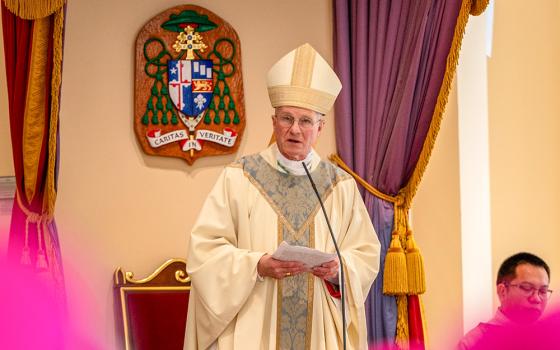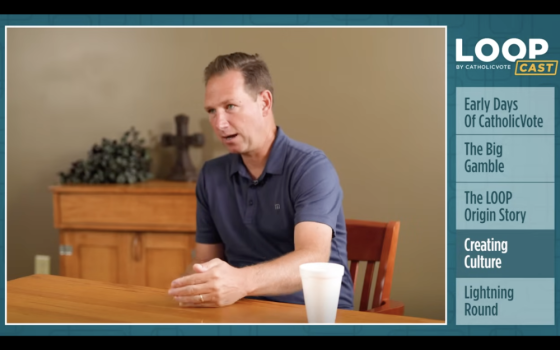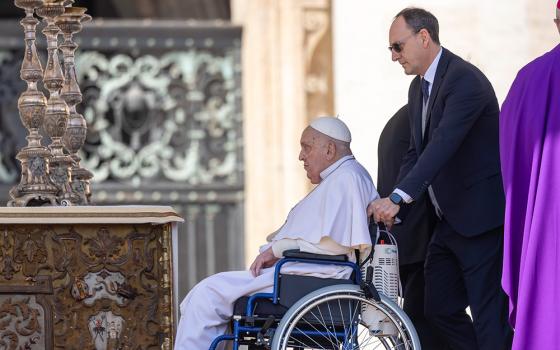
At the annual Ignatian Creators Summit, a three-day artists' retreat organized by the Jesuit Conference of Canada and the United States, Catholic artists of various mediums gather in community to connect and collaborate with one another. (Courtesy of Jesuit Conference of Canada and the United States)
St. Ignatius of Loyola believed that the imagination was a powerful tool in our spiritual lives. So, imagine with me:
A place where artists gather in community to connect and collaborate with one another. A supportive community where creatives are free to explore and take risks. A sacred space where they can pray together and rediscover the spiritual roots of their art.
That place exists: the annual Ignatian Creators Summit, a three-day artists' retreat organized by the Jesuit Conference of Canada and the United States, or JCCU, and held at Bon Secours Retreat and Conference Center in Marriottsville, Maryland. This year's summit was held at the end of July, when the grounds were alternately kissed by sun and soothed by rain. Mike Jordan Laskey, director of communications for the JCCU, introduced the summit as a "temporary alternative world" (drawing an idea from Priya Parker's The Art of Gathering): a special place set aside from the pressures and distractions of everyday life. As any artist knows, that sort of space is very rare — and very sacred.
I first attended the summit last year and for the first time I understood my writing, my art, not as something I do but as part of who I am, as essential to the person God is calling me to be as family life or ministry work. Just as important, I became part of a community of kindred spirits, creatives who spoke my spiritual language.
This year's group was the largest in program history, including 26 participants and four members of the communications team for the Jesuit Conference of Canada and the United States. The retreatants were writers, musicians, librettists, painters, digital creators, podcasters, laypeople, religious sisters and, of course, a few Jesuits.
As a high school campus minister by trade, I know the best way to explain a retreat isn't to tell you what happened, but what I learned. With that in mind I want to offer four major insights from this year's summit; fruits borne from conversation, creative activity and companionship.

NCR spirituality and culture editor Shannon Evans describes the landscape of Catholic media in a fishbowl-style panel on publishing. (Courtesy of Jesuit Conference of Canada and the United States)
1. The creative life involves risk. Bringing something new into the world requires leaping into the unknown. Even having the courage to see your art as worth creating and sharing is a risk. But the summit gave us a space where risk-taking was both possible and encouraged.
Renée Darline Roden, a journalist, Catholic Worker and playwright, led us in a flash playwriting exercise where we each wrote a short dialogue exchange in 10 minutes before sharing them. During a "Make Something" activity, we were given half an hour to create an original work in response to a Marc Chagall painting. The built-in limitations of these activities forced us out of our comfort zones and into the new. My usual tool is words, but during "Make Something" I found myself quickly assembling a short film. It wasn't Oscar-worthy, but it received a warm reception from our group and I was glad I'd stretched myself.
Catherine Sullivan, a writer and first-time summit participant, had a similar experience. "A room full of creatives might feel intimidating or even competitive, but the atmosphere at the summit was welcoming and generous, making it a safe space to practice taking creative risks," she said. "For the first time in many years, I felt brave enough to read a short piece of my fiction out loud to other writers because I felt secure in their genuine support."
Advertisement
2. The work is what matters. Working artists spend a lot of time worrying about outcomes. Will this connect, will this sell, am I building an audience effectively? We discussed those issues in practical terms during the summit, benefitting from the wisdom of our peers. But we also kept coming back to a deeper truth: In art, it's the work itself that matters. Creating is a form of prayer, a response to the stirrings of the Spirit in your heart that becomes physical.
Cameron Bellm, a Seattle-based writer, poet and retreat leader, said: "It was a powerful experience of being reintroduced to the thing that hums quietly in the background of our careers: the utter joy of creating something where there was nothing before, something that could only have been formed out of our own particular human experience, and by our own particular human body."
Creation is often a solitary act. It's necessary, but it can also be very lonely. One of the summit's greatest gifts was time spent with a community of people who spoke the same language, both the sacred tongue of artists and the spiritual vocabulary of the Ignatian tradition.
3. Creation happens in community. Creation is often a solitary act. It's necessary, but it can also be very lonely. One of the summit's greatest gifts was time spent with a community of people who spoke the same language, both the sacred tongue of artists and the spiritual vocabulary of the Ignatian tradition.
"Being in the same room as people who see and operate in the world in the same way I do was both healing and empowering," said Sullivan. In community we were able to spark off of each other's ideas and work together collaboratively.

Allison Beyer and H. Jay Dunmore discuss plans to combine their individual works into a moving musical performance. (Courtesy of Jesuit Conference of Canada and the United States)
At one point, Allison Beyer and H. Jay Dunmore combined individual works into a moving musical performance. The whole group traveled into Baltimore together for an Orioles game; and before the game, several members of our group shared brief, poetic reflections on how they see the numinous in America's pastime. And of course, we came together for Mass on the feast of St. Ignatius of Loyola, celebrated by Jesuits Fr. Martin Ngo and Fr. George Drance.
"Since writing, by its nature, is solitary, it was a gift to be in community with people who share a similar impulse for creativity as well as a common faith," said Erin Buckley, a writer and painter based in Richmond, Virginia. "A certain giddiness was in the air, like we were in art class (or a creative writing seminar) and we happened to be assigned group work with people who share our same heart, working with a common vision."
4. Creativity is sacred. More than a workshop or networking opportunity, the summit was a deeply spiritual experience. Art infused our prayer, including an audio divina meditation using classical music led by "Pray As You Go" director Emma Holland. And prayer suffused our art, reminding us that the act of creation is a holy one, a way of co-laboring with God to bring something new and beautiful into the world.

John Dougherty and Sr. Colleen Gibson discuss their creative practices at the Jesuit Media Lab annual summit. (Courtesy of Jesuit Conference of Canada and the United States)
Many of us use our art as a source of income, but the summit reminded us that we would still create even if there was no financial incentive. This is who God has called us to be. Writer and "Beyond the Habit" podcast co-host St. Joseph Sr. Colleen Gibson said it best during a reflection: "I create because it helps me know myself, my voice and God."
I am grateful for these insights and countless more from the summit, for the friendships we formed or strengthened and for the hard work that the staff of the Jesuit Conference of Canada and the United States puts into making this temporary alternative world a reality. As any creative person knows, it's easy to get discouraged, to feel like your work doesn't matter. The summit reminded me that it does matter, regardless of your book deals or follower counts. In a world scarred by violence and despair, we choose each day to try to make something beautiful. And as Dorothy Day liked to say, quoting Dostoevsky: "The world will be saved by beauty."






